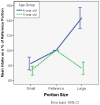Portion size variably affects food intake of 6-year-old and 4-year-old children in Kunming, China
- PMID: 23702260
- PMCID: PMC4319705
- DOI: 10.1016/j.appet.2013.05.010
Portion size variably affects food intake of 6-year-old and 4-year-old children in Kunming, China
Abstract
Age and portion size have been found to influence food intake in American children but have not been examined in an international context. This study evaluated the association between age and the effects of portion size on the food intake of kindergarteners in Kunming, China. Using a within-subjects crossover design in a classroom setting, 173 children in two age groups, mean age 4.2 years and 6.1 years, were served a predefined reference, small (-30%) and large (+30%) portion of rice, vegetables, and a protein source during lunchtime over three consecutive days. Each portion was weighed before and after the meal to determine amount of food consumed. Linear mixed modeling, controlling for repeated measures and clustering by classroom, was used to compare food intake under small and large portion size conditions to the reference portion. Children ate significantly less food when served small portions. When served a large portion, 6-year-old children increased food intake while 4-year-old children decreased food intake in comparison to the reference portion. Findings indicate that portion size affects food intake in Chinese children 4-6-years old. Older children show larger increases in food intake with increased portion size than do younger children.
Keywords: Children; China; Dietary intake; Kindergarten; Portion size; Preschool.
Copyright © 2013 Elsevier Ltd. All rights reserved.
Figures
References
-
- Addessi E, Galloway AT, Visalberghi E, Birch LL. Specific social influences on the acceptance of novel foods in 2–5-year-old children. Appetite. 2005;45(3):264–271. - PubMed
-
- Birch LL. Dimensions of preschool children's food preferences. Journal of nutrition education. 1979;11(2):77–80.
-
- Birch LL. Effects of peer models' food choices and eating behaviors on preschoolers' food preferences. Child development. 1980:489–496.
-
- Birch LL, Fisher JO. Development of eating behaviors among children and adolescents. Pediatrics. 1998;101(Supplement 2):539–549. - PubMed
-
- Birch LL, McPheee L, Shoba B, Steinberg L, Krehbiel R. “Clean up your plate”: Effects of child feeding practices on the conditioning of meal size. Learning and Motivation. 1987;18(3):301–317.
MeSH terms
Grants and funding
LinkOut - more resources
Full Text Sources
Other Literature Sources
Research Materials



